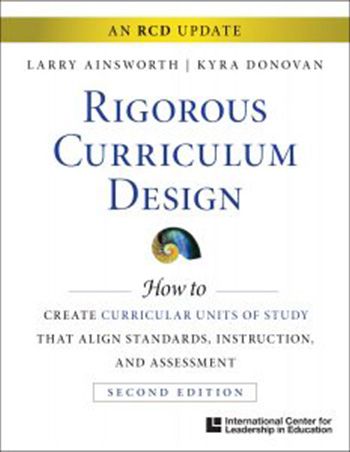TIMELESS PRACTICES TO IMPROVE STUDENT LEARNING
Supporting educators and leaders in their important work of helping every student become a confident and successful learner
Rigorous Curriculum Design
TIMELESS PRACTICE #5

BOOK DESCRIPTION:
Rigorous Curriculum Design, 2nd Edition (2019), co-authored by Larry Ainsworth and Kyra Donovan, presents a carefully sequenced, hands-on model for educators and curriculum designers. The RCD model has proven to be effective in school districts across the US, and it serves as a road map so that educators may design a progression of units of study that keep standards, instruction, and assessment tightly focused and connected.
Applicable to every grade, course, and content area—and all sets of standards, you will learn:
- What a rigorous curriculum is and how to create, sequence, and pace such a curriculum.
- Why seeing the ‘big picture’ connections first is essential to beginning curriculum design.
- How to lay the foundational steps for designing a rigorous pre-K–12 curriculum.
- How to design a grade- or course-specific curricular unit of study, from start to finish.
- How to use formative assessments and data analysis to guide instruction before, during, and after each unit.
- How leaders can organize, implement, and sustain this model throughout the school and/or school system.
This new edition of RCD shares updates and enhancements to the process, gained through nearly a decade of learnings from myriad schools. Success stories from school systems that have implemented the RCD model and experienced improved student learning on state exams
CONTENTS:
Part One: Building the Foundation for Designing Curricular Units—Dig Deep and Clarify the Focus
1. Prioritize the Standards
2. Decide on the Curricular Units of Study
3. Assign the Standards—Priority and Supporting
4. Prepare a Pacing Calendar
5. Customize the Unit Planning Organizer
Part Two: Designing the Curricular Unit of Study—Follow the Steps and Trust the Process
6. Decide Where to Start
7. “Unwrap” the Priority Standards
8. Create the Unit Assessments
9. Plan Engaging and Relevant Learning Experiences
10. Recommend Instructional Strategies
11. Detail the Unit Planning Organizer
12. Intentionally Plan and Administer the Unit of Study
Part Three: Implementing Rigorous Curriculum Design—Stay the Course and Continue the Journey
13. Begin the Journey: Year 1
14. Continue the Journey: Year 2
15. Sustain the Journey: Year 3 and Beyond


PROMINENT ENDORSEMENTS:
“In the second edition of Rigorous Curriculum Design, Larry Ainsworth and Kyra Donovan address the core issue of enhancing students’ learning—ensuring that the taught curriculum emphasizes critical content that is embedded in well-structured units and lessons.”
—Robert J. Marzano, Chief Academic Officer, Marzano Research
“This second edition of RCD reminds educators that although standards will continue to change, understanding of how to collaboratively design meaningful and coherent standards-based curriculum is where our focus must be. The multiyear approach frames the big picture of curriculum design with strategies to support teacher teams in deepening their own learning and professional practice.”
–Dr. Karin Hess, author, A Local Assessment Toolkit to Promote Deeper Learning; President, Educational Research in Action, Underhill, Vermont
“The authors have brought clarity galore to a curricular terrain more often slathered with murk than lucidity. The book’s chapters offer practical guidance about the underpinnings of curricular units, the design of such units, and how to implement the insightful strategy called rigorous curricular design.”
–W. James Popham, Emeritus Professor, University of California, Los Angeles
“Rigorous Curriculum Design, 2nd Edition, by Larry Ainsworth and Kyra Donovan, is the ultimate guidebook for teachers striving to enhance student learning. It provides the framework for teacher creativity, innovation, and collaboration. This is not a cookie-cutter approach but rather a step-by-step process that gives teachers the professional autonomy to positively impact the academic lives of their students.”
–Bruce A. Hibbard, PhD. Superintendent, Franklin Township Community School Corporation, Franklin Township, Indiana
CLICK HERE TO RECEIVE MORE INFORMATION ABOUT THE UPDATED RIGOROUS CURRICULUM DESIGN 2ND EDITION!
RCD Endorsements by Curriculum Design Teams and District Leaders
East Hartford High School Curriculum Design Team, East Hartford, Connecticut:
“Your process is going great! We are enjoying every moment of our work (if you can call it ‘work’). Our first eight documents are comprehensive, clear, and all very strongly based on the standards. Curriculum makes so much sense now!”
“I can’t wait for you to see our final product… these units are quite rich. Our group worked … to make the curriculum accessible to the teachers. More importantly, I believe it is going to be extremely valuable to our students. As I said before, it all makes sense now!”
San Diego ELA Curriculum Design Team, Cohort 1, San Diego, California
“This has been really informative and a great learning process. I really like the layout [of the RCD model] and the way it is organized. I believe that makes it all so much more manageable.”
“Very intense but excellent work. Conversations between grade levels are worth the time. I feel like I’m getting so much more familiar with the Common Core standards and expectations.”
“I feel excited, yet exhausted! It has been a great experience so far.”
San Diego Math Curriculum Design Team, Cohort 1, San Diego, California
“It was great to have a couple of days to look at the standards and familiarize ourselves with them. It was great to see how the standards progressed over the grade levels, especially looking at the grade levels directly above and below our own.”
“The RCD process is well thought out and should result in quality units.”
“Having a wonderful time and everyone working on RCD is great!”
“I absolutely LOVE what we’re doing; it’s so important for our students…”
“It feels really good having a plan and I felt very confident going back to my site and sharing what I had learned. It reduced anxiety levels and made it very doable.”
Assistant Superintendent, Anaheim City School District, Anaheim, California
“As we visited classroom after classroom, the enthusiasm and engagement of the students within the units was amazing. We were pleased to see the increased opportunities for students
to engage in supported, oral language rehearsal of concepts and skills within the collaborative nature of the tasks.
“Teachers openly shared that the amount of planning required was more than they expected, but they were bursting at the seams to share success stories of low-performing students surpassing their expectations within the collaborative and authentic tasks.”
Board President, Anaheim City School District, Anaheim, California
“The Common Core standards and the development of specific units have given our district the opportunity to have greater teacher and student engagement. Teachers collaborated in the writing of the units, and students played a role in piloting and testing in each unit to check for effectiveness. I believe that the units will allow for creative flexibility for our teachers and students, and therefore will better prepare students to be independent innovative thinkers ready to take on the 21st-century world.”
Associate Superintendent, Raytown Quality Schools, Raytown, Missouri
“It is a shared feeling among district educators that the Common Core standards combined with Rigorous Curriculum Design will allow us to create and maintain a curriculum process and product that will stand the test of the rigorous performance assessments coming in the next two years. It is inspiring to watch what a dedicated teacher can do when given a strong curriculum, practiced techniques and the freedom and power to innovate.”
Director of Elementary and Federal Programs, McMinnville School District, McMinnville, Oregon
“When we finished the [Rigorous Curriculum Design] overview, the question was simply, ‘Do you, as teachers, want this kind of curriculum?’ ‘Can you see the benefits for yourselves and students?’ The answer was an overwhelming ‘YES!’ In fact, one fifth-grade teacher jumped out of her seat, threw her arms in the air, and said, “Let’s get started!”
“I think the model is a great way to help teachers reach more standards across different subject areas. I like how the performance tasks start at a low Bloom’s level and end at a higher level. I struggle with helping my students reach the “application” level and I think this model will help me get them there.”(McMinnville Teacher)
Director of Teaching and Assessment, West Hartford Public Schools, West Hartford, Connecticut
“West Hartford is a high-performing school district with the vision that high expectations for all learners, rigorous and relevant curriculum, and dynamic teaching inspire a passion for learning and help all students realize their potential. We have always worked in the best interest of our students, but consistency and coherence across the curriculum were not well defined. As a result, the text became the curriculum and the level of rigor and expectations varied across the schools. What we have done this year in adopting the Rigorous Curriculum Design model, prioritizing the Common Core State Standards, and raising rigor and relevance through our units will define our future.
“It was extremely rewarding to see our first units take shape and reflect on how far we had come over a four-month span of time. One participant aptly summed up the experience when stating that the most beneficial part of this process was ‘being able to discuss curriculum with colleagues K–12; seeing the vertical alignment we never have time to see; having time to have meaningful discussions on curriculum.’”
Superintendent, Barstow Unified School District, San Bernardino County, California
“When Barstow Unified School District embraced the Common Core State Standards Initiative, we were fortunate to have developed a relationship with The Leadership and Learning Center to guide us in (the RCD) process. Throughout our ongoing teacher training, their consultants have empowered our teacher leaders in building the best lessons and environments for their classrooms by creating clear and realistic goals for student learning.”
District Leaders, Hemet Unified School District, Riverside County, California
“Our teams understood that in order to meet the needs of our 21st century learners, and the demands of the Common Core State Standards, we needed to do what we had not done before. No longer would we work in grade level/discipline isolation and follow a lock-step program. We were going to design (RCD) curricular units of study that thoughtfully and strategically placed all the pieces together.”
Grade 6 ELA Teacher Leader and Unit Writer, Guilford County Schools, Guilford County, South Carolina
“The (RCD) process was a roller-coaster ride because we really didn’t know what was expected in the very beginning. Previously our units were more topical than conceptual. We no longer have any novel studies in the sixth grade. We had to redefine what is meant by ‘text’ and that
has an impact on developing our units. Real-world assessments will take the place of quizzes and tests. That will be a real change!”
A Guilford County high school ELA teacher writer who piloted RCD unit with her students:
“The exemplar unit allowed us to take what we thought would be a difficult standard and successfully teach it to a wide range of learners. Having the resources from the unit allowed me to work creatively with my students to make sure they were each able to complete the tasks at hand. The students enjoyed the engaging scenario, and they were able to branch out well beyond just writing about what they had learned. They were able to use visuals, technology, and their speaking skills, and create a product they were proud to share with other classes.”
Assistant Superintendent West Haven Public Schools, West Haven, Connecticut
“The difference was noticeable to me immediately. After a brief presentation to the teams, the discourse began. After a while, our visitors, other school districts, and a college professor let us know that they were amazed at the quality of conversation they were hearing around the development of curriculum and its alignment to the Common Core State Standards. The conversations were rich and thoughtful. Teachers were automatically going through the Rigorous Curriculum Design process not only because they had experience with writing curriculum, but also because they understood its meaning. Further, they realize that if we continue on this path, we will be successful.”
A West Haven Leader
“Our curriculum is more focused. It is based on the CCSS, not on the published resources we have. It is integrated. It is meaningful. It allows for differentiated instruction. It encourages both student independence and collaborative work.”




